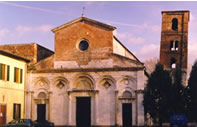Pisa - Church of San Michele degli Scalzi

The Church of San Michele degli ScalziTo the south, it is sided by a brick bell-tower with a stone base characterized by a strong inclination. Numerous elements of this church remind of the Romanesque-Pisan architecture of the Dome, such as the use of marble and the facade division in five arcades that rest on semicolons. The church and the monastery of San Martino degli Scalzi were built upon a pre-existing oratory around the first half of the XII century, when the Republic of Pisa was at its apex. Between 1152 and 1171, the structures were finished and this complex was given to the Benedictine monks who came from the Pulsano mountain in Apulia. These friars, who were called "scalzi", also worked to embellish the building beyond practising their religious activity. In 1168, they finished a cycle of frescoes on the life of Isaac. Unfortunately, only some traces were left of them and some fragments are kept inside the Museo Nazionale San Matteo. All the work were finished at the beginning of the XIII century. The monastery was given to other religious orders several times. In 1412, it was handed to the Augustinians while in 1463 Pius II gave it to the Canons of the Lateran. At the beginning of the XVII century, the church was modified. Some vaults were added to the to the nave and isles and windows were created instead of the embrasures. In 1627, the cloister was completed. In 1784, after a period when the Tuscan Grand Duke had taken his goods, the monastery passed to the Olivetans, who made further ornamental works. Fifty years later, the church was riconsecrated and it recovered its beauty through restorations. Also during the XX century numerous works were made, but during the Second World War the church underwent new damages and the bell-tower was the only structure saved. Unfortunately, its unlucky destiny did not stop with the end of the conflict. The flood of the river Arno in 1949 restarted its process of decay. Inside the church, it is possible to admire a XIII-century cross coming from the church of San Giovanni Decollato with a style that is typical of Pisa and Lucca and of which Berlinghiero was the main supporter. Yet, this work was attributed to the juvenile production of Giunta Pisano because of a certain Byzantine influence. The author, who was conventionally called "Maestro di Calci e Croci", remains still unknown. Instead, the relief with the pantokrator Christ , that is set above the apse, and the 42 decorative ceramic basins coming from different parts of the Mediterranean region were transferred to the Museo Nazionale of San Matteo. rises in an area of Pisa called Orticaria to the right of the Arno river. It is dates to the XII century, but it is was built in a place where there was a church since the year 1025. It is a building with a basilican layout, a saddleroof and a facade with three entrances.
To the south, it is sided by a brick bell-tower with a stone base characterized by a strong inclination.
Numerous elements of this church remind of the Romanesque-Pisan architecture of the Dome, such as the use of marble and the facade division in five arcades that rest on semicolons.
The church and the monastery of San Martino degli Scalzi were built upon a pre-existing oratory around the first half of the XII century, when the Republic of Pisa was at its apex.
Between 1152 and 1171, the structures were finished and this complex was given to the Benedictine monks who came from the Pulsano mountain in Apulia.
These friars, who were called "scalzi", also worked to embellish the building beyond practising their religious activity. In 1168, they finished a cycle of frescoes on the life of Isaac.
Unfortunately, only some traces were left of them and some fragments are kept inside the Museo Nazionale San Matteo. All the work were finished at the beginning of the XIII century. The monastery was given to other religious orders several times. In 1412, it was handed to the Augustinians while in 1463 Pius II gave it to the Canons of the Lateran.
At the beginning of the XVII century, the church was modified. Some vaults were added to the to the nave and isles and windows were created instead of the embrasures. In 1627, the cloister was completed.
In 1784, after a period when the Tuscan Grand Duke had taken his goods, the monastery passed to the Olivetans, who made further ornamental works. Fifty years later, the church was riconsecrated and it recovered its beauty through restorations.
Also during the XX century numerous works were made, but during the Second World War the church underwent new damages and the bell-tower was the only structure saved. Unfortunately, its unlucky destiny did not stop with the end of the conflict. The flood of the river Arno in 1949 restarted its process of decay.
Inside the church, it is possible to admire a XIII-century cross coming from the church of San Giovanni Decollato with a style that is typical of Pisa and Lucca and of which Berlinghiero was the main supporter. Yet, this work was attributed to the juvenile production of Giunta Pisano because of a certain Byzantine influence.
The author, who was conventionally called "Maestro di Calci e Croci", remains still unknown. Instead, the relief with the pantokrator Christ , that is set above the apse, and the 42 decorative ceramic basins coming from different parts of the Mediterranean region were transferred to the Museo Nazionale of San Matteo.